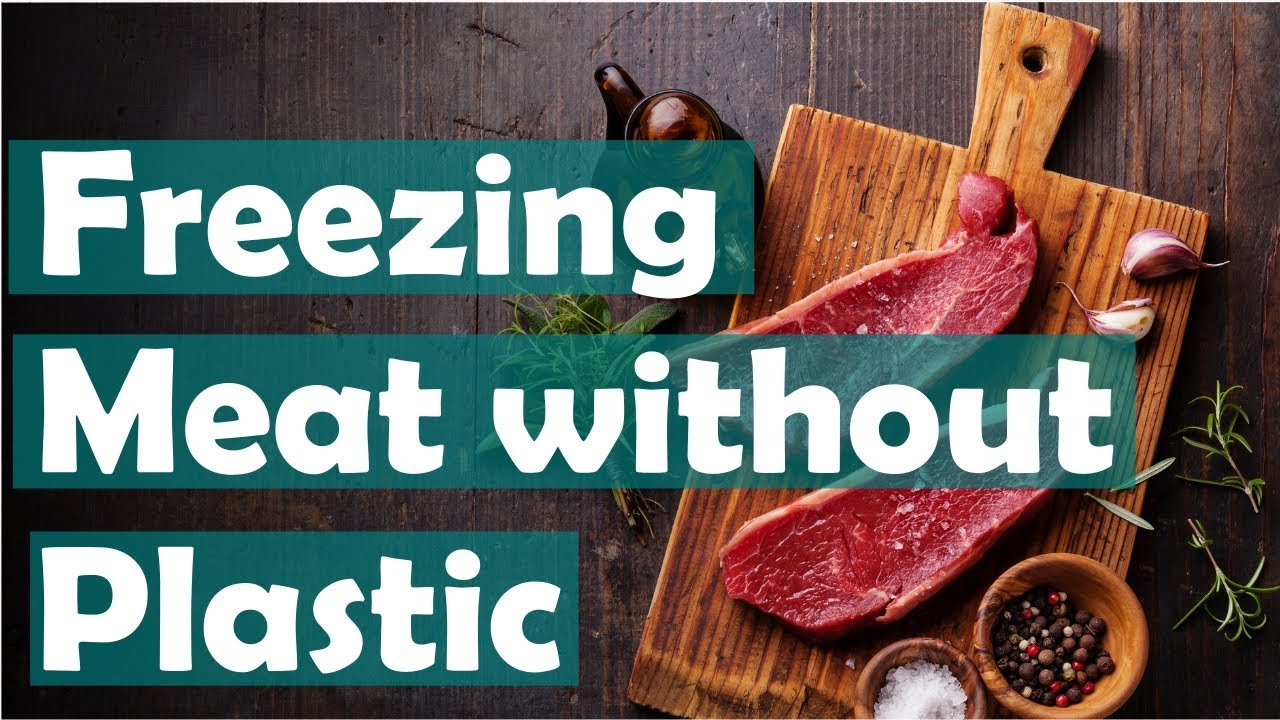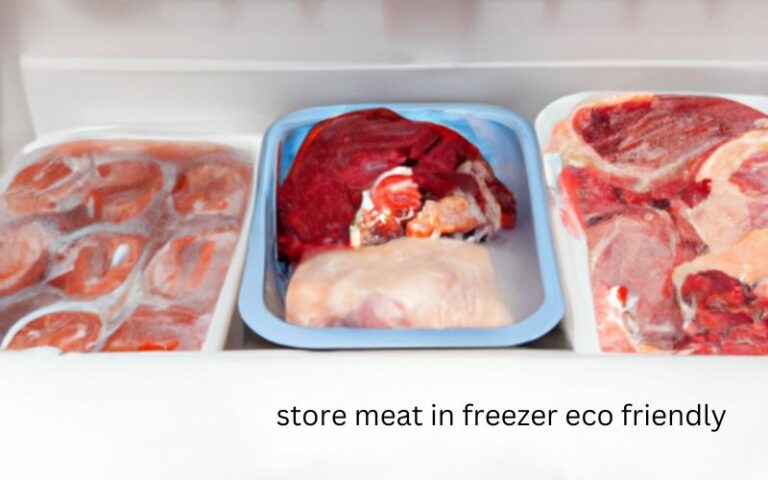How to Freeze Meat Without Plastic
Today we discuss How to Freeze Meat Without Plastic. You’ve come to the right place! Freezing meat without plastic is not only better for the environment but also helps in reducing plastic waste. So, how can you freeze meat without plastic?
It’s simpler than you might think. In this article, we will explore different methods and alternatives that allow you to safely freeze your meat without relying on plastic packaging. Not only will this help you minimize your ecological footprint, but it will also help you maintain the quality and freshness of your meat for longer periods. Let’s dive in!
How to Freeze Meat Without Plastic
Freezing meat is an excellent way to preserve it for future use. However, using plastic packaging for freezing meat can have adverse environmental impacts. Plastic takes hundreds of years to decompose and contributes to pollution and landfill waste. Thankfully, there are alternative methods to freeze meat without relying on plastic. In this article, we will explore various techniques and eco-friendly options for freezing meat without plastic.
1. Use Glass Containers or Jars
One effective method for freezing meat without plastic is to use glass containers or jars. Glass is a sustainable and reusable material that does not leach harmful chemicals into your food. Here’s how you can freeze meat using glass containers:
– Choose glass containers with airtight lids that are appropriate in size for the amount of meat you want to freeze.
– Clean the glass containers thoroughly with hot, soapy water, and rinse them well.
– Pat the meat dry and cut it into suitable portions for future use.
– Place the meat pieces into the glass containers, leaving enough space for expansion during freezing.
– Seal the containers tightly and label them with the date and type of meat.
– Place the containers in the freezer, ensuring they won’t touch each other to allow for efficient air circulation and even freezing.
Why Glass Containers?
Using glass containers to freeze meat offers several benefits:
– Environmentally-friendly: Glass is a recyclable material that doesn’t contribute to plastic waste.
– Chemical-free: Unlike some plastic containers, glass does not release harmful chemicals into your food.
– Long-lasting: Glass containers are durable and can be reused multiple times, reducing the need for single-use plastic.
2. Wrap Meat in Butcher or Freezer Paper
Another alternative to plastic packaging is using butcher or freezer paper to wrap meat. Butcher paper is a sturdy paper designed specifically for wrapping meat, while freezer paper has a wax coating that helps preserve the quality of frozen food.
Here’s how you can use butcher or freezer paper to freeze meat:
– Cut a large sheet of butcher or freezer paper.
– Place the meat on the paper and fold it over to cover the meat completely.
– Fold the edges of the paper tightly, securing the package.
– Label the package with the date and type of meat.
– For added protection, you can wrap the package again with aluminum foil or place it inside a paper bag.
Benefits of Butcher and Freezer Paper
Freezing meat with butcher or freezer paper offers several advantages:
– Sustainable: Both butcher and freezer paper are biodegradable and can be easily composted.
– Breathable: These papers allow the meat to breathe while protecting it from freezer burn.
– Versatile: Butcher and freezer paper can be used for wrapping various cuts of meat, ensuring flexibility.
3. Vacuum Sealers
Using a vacuum sealer is another effective method for freezing meat without plastic. Vacuum sealing removes air from the packaging, reducing the risk of freezer burn and preserving the flavor and quality of the meat.
Here’s how you can freeze meat using a vacuum sealer:
– Cut the meat into suitable portions and pat it dry.
– Place the meat inside a vacuum sealer bag or roll.
– Follow the manufacturer’s instructions to vacuum seal the bag, ensuring all the air is removed.
– Label the bag with the type of meat and the date.
Advantages of Vacuum Sealers
Vacuum sealing your meat provides several benefits:
– Extended shelf life: Vacuum-sealed meat can last longer in the freezer, maintaining its quality.
– Space-saving: Removing the air from the packaging allows for more compact storage.
– Versatility: Vacuum sealers can be used for a variety of foods, making them a versatile addition to your kitchen.
4. Beeswax Wraps
Beeswax wraps offer a sustainable and reusable alternative to plastic wrap for freezing meat. These wraps are made from organic cotton coated with a mixture of beeswax, tree resin, and jojoba oil, creating a flexible and washable covering for your food.
Here’s how you can use beeswax wraps to freeze meat:
– Cut a piece of beeswax wrap large enough to fully enclose the meat.
– Place the meat on the wrap and fold the edges over to cover it completely.
– Use the warmth of your hands to mold the wrap tightly around the meat, creating a seal.
– Label the wrapped meat with the appropriate details.
Benefits of Beeswax Wraps
Choosing beeswax wraps for freezing meat offers multiple advantages:
– Eco-friendly: Beeswax wraps are biodegradable and can be composted after their lifespan is over.
– Reusable: Beeswax wraps can be washed and used multiple times, reducing waste.
– Natural: The materials used to create beeswax wraps are non-toxic and sustainable.
5. Silicone Bags
Silicone bags are an excellent alternative to plastic zip-top bags for freezing meat. These bags are made from food-grade silicone and are durable, leak-proof, and easy to clean.
Here’s how you can use silicone bags to freeze meat:
– Cut the meat into suitable portions.
– Place the meat inside a silicone bag, ensuring the bag is not overfilled.
– Squeeze out excess air and seal the bag tightly.
– Label the bag with the date and type of meat.
Advantages of Silicone Bags
Opting for silicone bags for freezing meat offers several benefits:
– Reusability: Silicone bags are long-lasting and can be used repeatedly, reducing waste.
– Easy to clean: These bags are dishwasher-safe or can be easily hand-washed.
– Versatility: Silicone bags can also be used for sous vide cooking or storing other food items.
6. Aluminum Foil
While not entirely plastic-free, aluminum foil can be an acceptable option for freezing meat if used sparingly and responsibly. Aluminum foil is easily recyclable, making it a better alternative to single-use plastic bags or wrap.
Here’s how you can use aluminum foil to freeze meat:
– Cut a sheet of aluminum foil large enough to wrap the meat fully.
– Place the meat in the center of the foil and fold the edges tightly to seal it.
– Label the package with the date and type of meat.
The Aluminum Foil Advantage
Aluminum foil offers the following advantages:
– Recyclability: Aluminum is one of the most recyclable materials, reducing environmental impact.
– Effective insulation: Foil helps protect the meat from freezer burn and retains its moisture.
– Versatile: Aluminum foil can be shaped and molded to fit various meat cuts, ensuring optimal packaging.
7. Cloth Wrappings
Using cloth wrappings is a sustainable way to freeze meat without plastic. Cloth provides a breathable and natural covering for your meat, allowing it to freeze while retaining its quality.
Cloth Wrap Options
Here are a few cloth wrapping options you can utilize:
– Muslin cloth: A plain-woven cotton fabric that is breathable and suitable for wrapping meat.
– Tea towels: These absorbent and reusable cloths work well for wrapping meat portions.
– Fabric bags: Sewing fabric bags in suitable sizes for different cuts of meat is a customizable option.
How to Use Cloth Wrappings
Follow these steps to freeze meat using cloth wrappings:
– Clean and dry the cloth thoroughly before use.
– Wrap the meat tightly with the cloth, ensuring no exposed areas.
– Use butcher’s twine or rubber bands to secure the cloth firmly.
– Label the wrapped meat with the required information.
8. Stainless Steel Containers
Stainless steel containers are a durable and eco-friendly option for freezing meat. They are an excellent alternative to plastic containers and can be reused multiple times.
Here’s how you can freeze meat using stainless steel containers:
– Select stainless steel containers with airtight lids that fit the meat portions.
– Clean the containers thoroughly with hot, soapy water and rinse them well.
– Pat the meat dry and place it inside the containers.
– Seal the containers tightly and label them with the necessary details.
– Store the containers in the freezer, ensuring proper air circulation.
The Advantages of Stainless Steel
Using stainless steel containers for freezing meat provides several perks:
– Reusability: Stainless steel containers are long-lasting and can be used repeatedly.
– Non-toxic: Stainless steel does not leach harmful chemicals into your food.
– Sturdy: These containers are resistant to breaking, corrosion, and staining.
9. Silicone Stretch Lids
Silicone stretch lids offer a versatile and eco-friendly way to cover meat during freezing. These lids are made from food-grade silicone and come in various sizes to fit different containers.
Here’s how you can use silicone stretch lids to freeze meat:
– Place the meat inside a suitable container.
– Stretch the silicone lid over the container, ensuring a tight seal.
– Label the container with the necessary information.
Benefits of Silicone Stretch Lids
Using silicone stretch lids for freezing meat comes with numerous advantages:
– Reusability: Silicone stretch lids can be washed and reused multiple times, reducing waste.
– Flexibility: These lids fit various container sizes, providing versatility in your kitchen.
– Airtight seal: Silicone stretch lids create an airtight seal to preserve the quality of the meat.
10. Choose Plastic-Free Packaging Options
Apart from the various methods mentioned above, it is essential to consider purchasing meat from sources that offer plastic-free packaging options. Look for farmers’ markets, local butchers, or online suppliers that prioritize eco-friendly packaging materials. Choose options like paper wraps, compostable bags, or reusable containers.
Making a Positive Impact
Opting for plastic-free packaging options benefits both the environment and your health. By supporting businesses that prioritize sustainable packaging, you are encouraging the reduction of plastic waste and promoting a more eco-conscious society.
In conclusion, freezing meat without plastic is possible by utilizing alternative packaging methods such as glass containers, butcher or freezer paper, vacuum sealers, beeswax wraps, silicone bags, aluminum foil, cloth wrappings, stainless steel containers, silicone stretch lids, and opting for plastic-free packaging options. These alternatives not only help reduce plastic waste but also ensure the quality and longevity of your frozen meat. By making a conscious effort to freeze meat without relying on plastic, you contribute to a healthier planet and a sustainable future.
Freezing meat without plastic – Eco options for keeping meat in the freezer
Frequently Asked Questions
Can you freeze meat without using plastic?
Yes, there are several alternative methods to freeze meat without relying on plastic. By using these methods, you can safely store your meat while minimizing the use of plastic containers or bags.
What are some alternatives to plastic for freezing meat?
Some alternatives to plastic when freezing meat include using glass containers with tight-fitting lids, stainless steel containers, silicone storage bags, or wrapping the meat in butcher paper or wax paper.
How do I freeze meat in glass containers?
To freeze meat in glass containers, make sure the container is freezer-safe and has an airtight lid. Leave some space at the top of the container for expansion, especially if using a liquid marinade. Label the container with the date and contents, and place it in the freezer.
Can I use stainless steel containers to freeze meat?
Yes, stainless steel containers can be used to freeze meat. Ensure the container is freezer-safe and has a tight-sealing lid. Just like with glass containers, leave some room for expansion, label the container, and place it in the freezer.
Are silicone storage bags a good option for freezing meat?
Yes, silicone storage bags are an eco-friendly alternative to plastic bags for freezing meat. Look for bags specifically designed for freezing, with airtight seals and a sturdy construction. Place the meat inside, seal the bag tightly to prevent air exposure, and freeze it.
What is butcher paper, and can I use it to freeze meat?
Butcher paper is a food-grade paper that is used for wrapping and storing meat. It is a great option for freezing meat as it allows for breathability and helps prevent freezer burn. Wrap the meat tightly in butcher paper, making sure it is completely covered, and store it in the freezer.
Can I use wax paper to freeze meat?
Wax paper can be used to wrap individual cuts of meat for freezing. However, keep in mind that it is not as durable as other materials and may not provide as much protection against freezer burn. Consider using a double layer of wax paper or transferring the wrapped meat to a container or bag for added protection.
Final Thoughts
Freezing meat without plastic is a sustainable and eco-friendly alternative for preserving food. By utilizing natural alternatives such as wax paper, aluminum foil, or glass containers, we can eliminate the need for plastic in our freezing process. Additionally, vacuum sealing and utilizing airtight containers help maintain the quality and freshness of the meat. With proper labeling and organizing techniques, it becomes easier to locate and use frozen meat without wastage. By adopting these plastic-free methods, we can contribute to a greener and healthier environment while still enjoying the convenience of frozen meat.



